Yes, Project Resources Need Vacations Too…
Everyone loves a vacation! And most of us look forward to that much-needed (and mostly deserved) time away from work! And, whether those vacations are ‘stay-cations’ or well-planned global adventures, the bottom line is, time off means resources will not be available for project work. All Project Managers (PMs), including myself, believe our project is the most important project underway, and all planned vacations and time off from work should be put on hold until our project is complete, but that is not reality. So, as with all other good resource management principles and best practices, it is critically important that PMs account for time resources that will not be available for project work, including administrative overhead work, training, and PTO/Vacations.
Every enterprise resource managed in MS Project Server/Project Online has his/her own ‘Resource Calendar’ assigned. The assigned resource calendar is used by MS Project to schedule task assignments, whenever an enterprise resource is assigned to a task in an enterprise project schedule. The default ‘Standard Calendar’ assigned to each Enterprise Resource has work hours from ‘8AM – 12PM’ and ‘1PM – 5PM’, Monday – Friday. Saturdays and Sundays; however, are configured as non-working days, which means MS Project will NOT assign on Saturdays or Sundays. In addition, if company-observed holidays are included as ‘Exception’ days in the calendar, then MS Project will NOT assign work on those holidays (exception days) either.
Since the resource-assigned calendar drives the scheduling of task assignments in MS Project, then it is important that the resource calendars are updated to reflect when the associated enterprise resource will be available for work. And with the use of MS Project Server/Project Online, a common question is how should organizations, manage resource vacation schedules to impact capacity planning and project scheduling? As a result, we will attempt to illustrate the various methods to ensure time away from work is accounted for in your enterprise project schedules and capacity planning efforts. This is especially important for your critical resources. For MS Project Server/Project Online users, updating the resource calendar, for each appropriate Enterprise Resource, or leveraging the ‘Timesheet’ functionality (even if your organization is not using MS Project Server/Project Online ‘Timesheets’ to process timesheets) are excellent methods for ensuring project resource’s time away from work is accounted for when scheduling and managing projects.
| HELPFUL HINT: Organizations can copy the ‘Standard Calendar’ and adjust to reflect the standard workday to reflect each region represented by their enterprise resources. If your organization has resources in multiple regions (i.e. US, Canada, Europe, India, etc.), then the calendar for the region should be assigned to the appropriate resource, based on their locality. For example, all US-based resources should have the ‘US Calendar’ assigned, all resources in Canada should have the appropriate CA calendar assigned, etc. These regional calendars should also reflect the company-observed holidays for each region included. |
Using MS Project to Update Enterprise Resource Vacation Schedules
If using MS Project Server/Project Online Timesheets functionality is not an option, another method for capturing time away from work for enterprise resources is to have either Resource/Functional managers or designated resources with access to edit enterprise resources in MS Project Server/Project Online, manually update the resource calendar, for each appropriate Enterprise Resource that has planned time-off.
To update resource calendars in MS Project Server/Project Online, users must have the following credentials:
- Permission/access to view Project Online resources in the ‘Resource Center’, via the RBS (if the RBS is enabled)
- Permission to ‘Edit Enterprise Resource Data’
Have a licensed copy of MS Project Professional installed on their computers
To update enterprise resource vacation schedules, users with the appropriate access should:
- Navigate to the ‘Resource Center’ in your MS Project Server/Project Online environment.
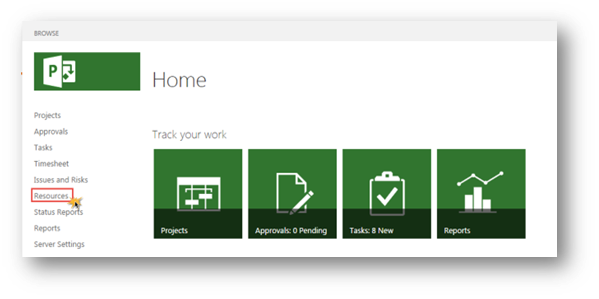
- Locate and select the desired resources, then click Open (in MS Project) in the ‘Resources‘ section of the ‘Resources‘ tab.

- Click Yes, when prompted, to launch MS (Microsoft) Project with the selected resources.
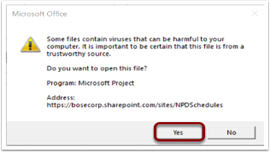
- In MS Project Professional, right-click on the desired resource and select ‘Information‘ to activate the (Resource) ‘Information’ screen.
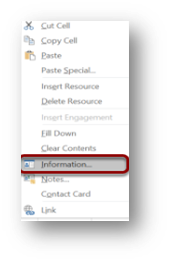
- ‘Change Working Time’ by clicking the ‘Change Working Time…‘ button in the ‘Resource Information’ dialogue box, to access the selected resource’s calendar.
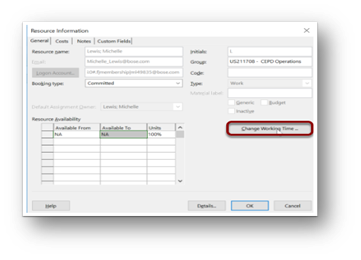
- Enter the (Work) ‘Exceptions’ as appropriate, then click OK to exit the ‘Change Working Time‘ screen.
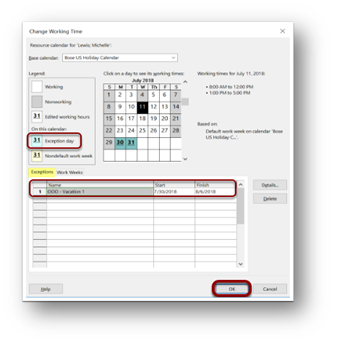
- Click OK to exit and close the (Resource) ‘Information‘ dialogue box.
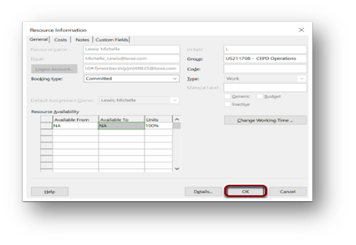
- After all of the selected enterprise resource calendars have been updated, go to File >> Save in MS Project Professional to save the updates.
- Click File >> Close to check in the checked-out enterprise resources.
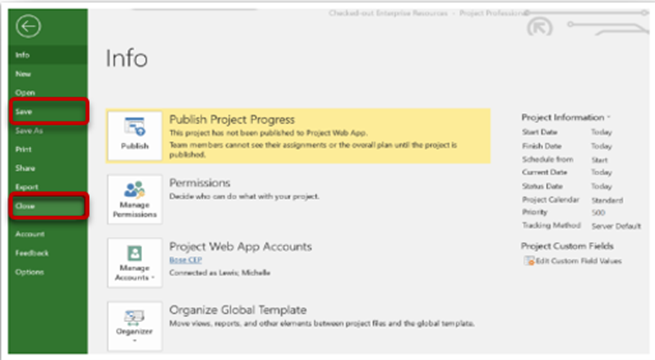
Leveraging MS Project Server/Project Online Timesheets
Using MS Project Server/Project Online Timesheets, enterprise resources (with PWA licenses and accounts, of course) can update their own calendars, as needed to plan for time away from work. By accessing ‘Manage Timesheets’ via PWA’s Quick Launch Pane -or- from the ‘PWA Settings’, project resources will be able to view and access all past, current, and future timesheets. The future timesheets; however, should be used to plan time off from work.
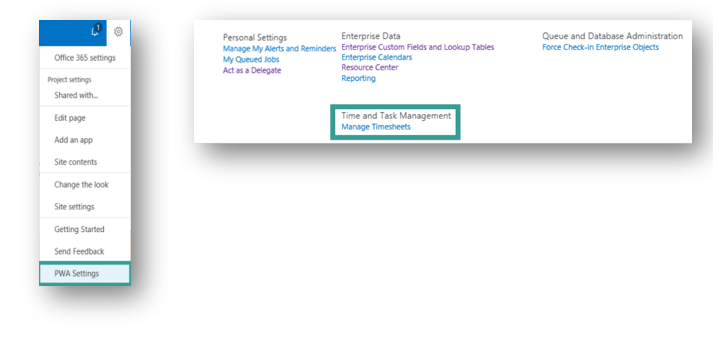
To update their resource calendar with planned time off from work, users should:
- Locate the desired ‘timesheet period’ they are planning on the ‘Manage Timesheets’ page and select ‘Click to Create’ to create a timesheet for the specified period.
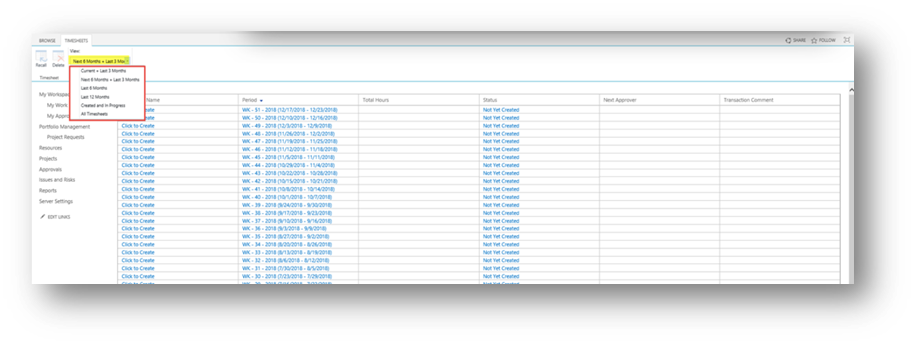
- After the future timesheet is created (or opened if previously created), use the ‘Add Row >> Add Non-Project Line’ option (i.e., PTO, Vacation, Training, etc.).

- In the ‘Administrative Time’ dialogue box, select the desired category (i.e., PTO, Vacation, Training, etc.), then click OK to add the task(s) to your current timesheet.

- On the updated timesheet row, locate the row with the appropriate category (i.e., ‘Vacation’ to submit planned vacation time), then enter the planned hours on the appropriate day(s), on the ‘Planned’ row.
- After the hours are entered, click Save to save the entries and update the associated resource’s calendar as appropriate.

| HELPFUL HINT: If updating multiple timesheet periods, click Next to create and update the next timesheet period. Click Select Period and enter the appropriate date (or nearest date) to create and update a timesheet for a different period of time in the future. |
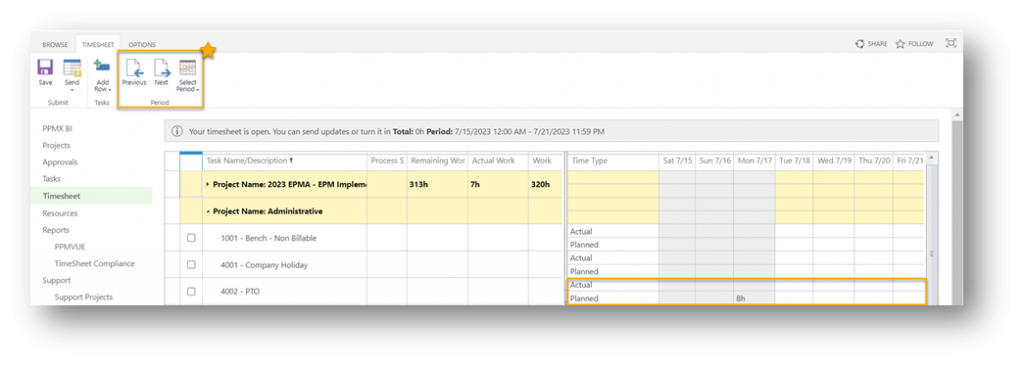
| HELPFUL HINT: Saving timesheets is sufficient when updating the associated resource calendar with non-working time. Sending/Submitting timesheets is NOT required. |
Verify Resource Capacity Updates in Project Online
To verify resource calendars updated by either method mentioned above, review the default, OOO (Out-of-Box) ‘Capacity Planning’ views in PWA by:
- Navigating to the ‘Resource Center’ in your MS Project Server/Project Online environment.
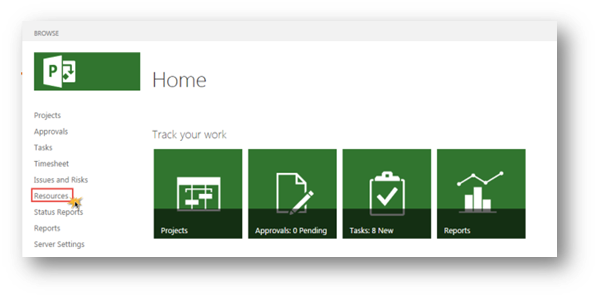
- Locate and select the desired resources, then click Capacity Planning in the ‘Navigate‘ section of the ‘Resources‘ tab.

- Navigate to the ‘Remaining Availability‘ view, then update the ‘Set Date Range‘ values to reflect the appropriate date range.

| HELPFUL HINT: Set the ‘Timescale‘ units (‘Filters’ section of the ‘Availability’ tab) to ‘Days‘. |
- Review the graph and the supporting data table (located below the graph) to verify resource capacity updates.

Summary
In summary, when planning and executing projects and ensuring that the resources are available to work on those projects, especially during those critical times, it is imperative that organizations are aware of and can account for project resource availability across the organization. Furthermore, it is not just project vs. non-project work allocations that provide valuable insight to managing projects, but knowing when resources will not be available at all, because they are ‘out of office’, gone fishin’ for the day, week, or even a month is invaluable! When you are aware that a critical resource is planning to be out of the office, and unavailable for work ahead of time, it gives you time to plan for their absence. BUT…if the project schedule can make the necessary adjustments for you, you can get a heads-up on the project impacts of that upcoming PTO. This will help put you in a better position to make the necessary adjustments to keep the project on track, in spite of their absences. So, while you may still believe your project is the most important project underway and all planned vacations and time off from work should be put on hold until your project is complete, if resource calendars are updated using one of the methods detailed above, you will at least be in a better position to keep your project on track and manage in a proactive manner, as opposed to reacting once you find out or are reminded about the vacation when it’s almost too late.
EPMA is a global solutions company focused on delivering projects better. Our unique proposition that embodies the full ecosystem and portfolio of any organization has enabled us to deliver projects better and make a significant difference. Our unique and proactive approach of having over 20 developers and solutions architects in the business acts as a true enabler for impact. We are more than ever before positioned to add value, advise, and impact your organization.
Interested in hearing more? Please contact EPMA at 832.772.3762 or email us at [email protected]

